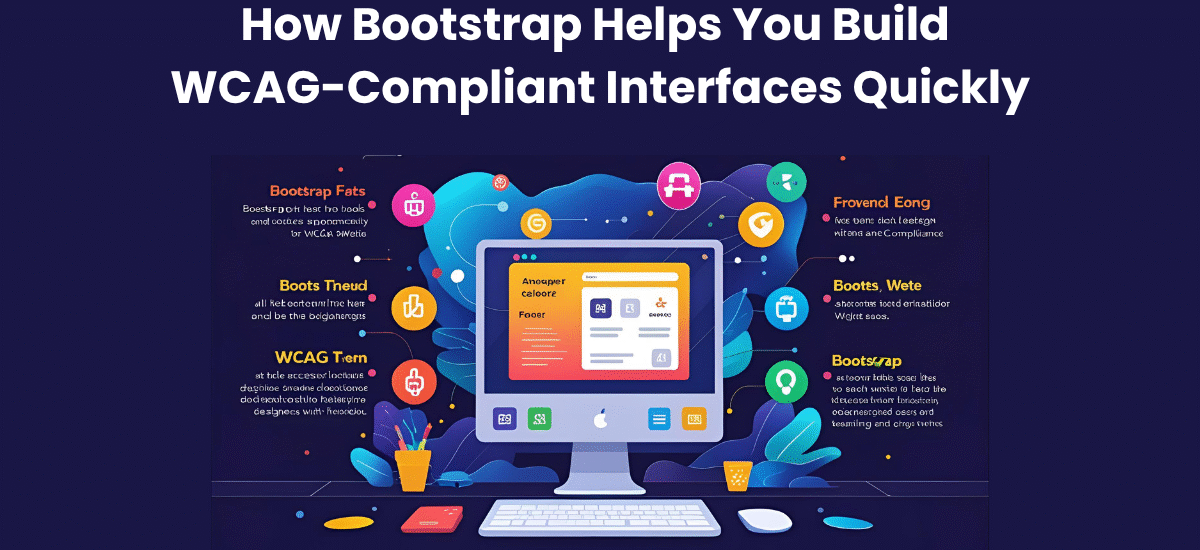The Web Content Accessibility Guidelines (WCAG) provide an international standard for making web content more accessible to users with disabilities. The WCAG includes guidelines to improve accessibility for people with vision, hearing, mobility, and cognitive impairments.
However, implementing WCAG from scratch often requires deep technical understanding, time, and resources. That’s why developers and product teams turn to Bootstrap Development Solutions. Bootstrap simplifies the process of building WCAG-compliant user interfaces by offering ready-made, accessibility-aware components and design patterns.
Why Accessibility Matters More Than Ever
Digital accessibility is no longer optional. Here’s why:
- 1.3 billion people worldwide live with some form of disability (WHO).
- Legal mandates, such as the ADA, Section 508, and EN 301 549, require digital content to be accessible.
- SEO and usability improve when accessibility is implemented.
- Companies face fines and lawsuits for inaccessible websites.
- An accessible site is inclusive, benefiting all users, including those using mobile devices or slow internet connections.
Bootstrap, when used wisely, helps teams build accessible experiences efficiently and at scale, reducing risks while enhancing usability.
How Bootstrap Supports WCAG Compliance — An Overview
Bootstrap has baked accessibility into its design:
- Components come with ARIA attributes for screen reader compatibility.
- Focus management and keyboard navigation are handled automatically in many elements.
- Visual feedback (like color contrast, hover, and focus states) adheres to WCAG standards.
- Form components include clear labels, feedback indicators, and required field notifications.
Whether you’re building a simple landing page or a complex dashboard, Bootstrap makes it easier to comply with WCAG without reinventing accessibility patterns.
Key WCAG Principles and Bootstrap’s Role
Let’s explore how Bootstrap aligns with WCAG’s four principles:
A. Perceivable
Users must be able to perceive the content, regardless of their sensory abilities.
Bootstrap’s Contributions:
- Provides semantic HTML elements such as buttons, headers, navigation menus, and modals that assist screen readers.
- Allows use of alt text for images and icons to help visually impaired users understand visual elements.
- Forms include labels and placeholders, and alerts can include contextual messages that are also accessible by screen readers.
Example: A Bootstrap alert can notify users about an error using both color and text, ensuring the message is visible and perceivable to everyone.
B. Operable
Users must be able to operate the interface with keyboard or assistive devices.
Bootstrap’s Contributions:
- Built-in components like modals, dropdowns, tabs, carousels, and navbars support keyboard navigation.
- Visual focus indicators help users see where they are in the tab order.
- JavaScript plugins ensure that when modals are opened, focus is moved inside them, and returned appropriately when closed.
Example: A user with limited mobility navigating with only a keyboard can interact with a Bootstrap navbar, dropdown, or modal without issue.
C. Understandable
Information and UI must be clear and predictable.
Bootstrap’s Contributions:
- Uses consistent component patterns, such as uniform buttons, forms, and alerts.
- Forms provide real-time validation feedback (e.g., green/red highlights with accessible messages).
- Tooltips and badges can be used to add clarity without overwhelming the user.
- Built-in utility classes help designers structure content logically and consistently.
Example: A form using Bootstrap will guide users with clearly labeled fields, inline error messages, and consistent layout — minimizing confusion.
D. Robust
Content must work reliably across browsers and assistive technologies.
Bootstrap’s Contributions:
- Components are tested across popular screen readers like NVDA, VoiceOver, and JAWS.
- Bootstrap ensures clean, valid HTML output that is future-compatible.
- Regular framework updates improve compatibility with emerging accessibility tech.
Example: Even when new assistive tech or browsers roll out, Bootstrap’s robust semantic structure ensures your UI remains accessible.
Bootstrap Features That Accelerate Accessibility
Here’s a breakdown of the features in Bootstrap that specifically make accessibility development faster and more reliable:
1. Semantic HTML Structure
- Bootstrap encourages correct use of native HTML tags like <nav>, <form>, <main>, and <button>.
- This helps assistive tech understand and navigate content meaningfully.
2. Built-in ARIA Attributes
- Components like modals, dropdowns, and accordions already include helpful ARIA roles and attributes.
- Examples include aria-expanded, aria-hidden, and aria-label, which assist screen readers and help developers avoid manual markup.
3. Focus States & Keyboard Navigation
- Bootstrap provides clear and consistent keyboard focus states, such as border outlines or background changes.
- It also traps focus within modals and navigates through elements in logical order.
4. Color Contrast and Visual Indicators
- Default color themes in Bootstrap have been designed to meet WCAG AA contrast ratios.
- Visual feedback for actions (e.g., hover, active, disabled states) is clearly distinguishable to users with visual impairments.
5. Responsive Design for Inclusive UX
- The responsive grid system ensures layout adapts to any screen size or zoom level.
- This benefits users with cognitive or visual challenges who rely on enlarged text or single-column views.
Challenges Bootstrap Helps You Avoid
With Bootstrap, you avoid several pitfalls that often plague accessibility-first development:
- Manually adding ARIA labels for every component.
- Overlooking keyboard navigation traps (especially in dynamic UI components).
- Unintentionally breaking screen reader support during custom styling.
- Ignoring color contrast guidelines, which leads to visual barriers.
Bootstrap automates or simplifies these tasks, so you can focus more on content and UX.
Best Practices When Using Bootstrap for Accessibility
Although Bootstrap does a lot for you, WCAG compliance is a shared responsibility between framework and developer. Here are best practices to follow:
- Add meaningful alt text to all images and icons.
- Use the .visually-hidden class to hide elements visually but keep them readable by screen readers.
- Customize Bootstrap’s theme carefully — especially colors — and retest contrast ratios.
- Avoid hiding important information with display: none without providing accessible alternatives.
- Run regular accessibility audits using tools like Axe, Wave, or Chrome’s Lighthouse.
- Test manually with a keyboard and screen reader, especially for forms, modals, and navigation.
Conclusion
Incorporating accessibility from the start is no longer a bonus — it’s a business necessity. Bootstrap Development Solutions give developers a head start on WCAG compliance by offering:
- Pre-built accessible components
- Semantic HTML structures
- ARIA support
- High-contrast themes
- Keyboard-friendly interactions
By relying on Bootstrap’s accessibility features and following best practices, developers can build inclusive, user-friendly, and legally compliant interfaces faster — without compromising on performance or aesthetics.
FAQs
Q1. Is Bootstrap alone enough for full WCAG compliance?
No, Bootstrap provides a strong foundation, but full compliance depends on your implementation of content, alt text, labeling, and custom styles.
Q2. What version of WCAG does Bootstrap support?
Bootstrap 5 generally supports WCAG 2.1 Level AA guidelines, especially for contrast, navigation, and ARIA usage.
Q3. Can I build accessible SPAs (Single Page Applications) with Bootstrap?
Yes, Bootstrap can be used with frameworks like React, Angular, and Vue — but you’ll need to manage dynamic ARIA updates and focus control carefully.
Q4. Are Bootstrap modals accessible?
Yes, Bootstrap modals include ARIA roles and focus trapping, but ensure proper labeling (aria-labelledby) and keyboard testing is done in your project context.






